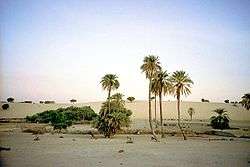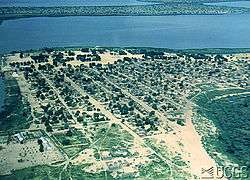Wildlife of Chad
The wildlife of Chad is composed of its flora and fauna. Animal and plant life correspond to the three climatic zones. In the Saharan region, the only flora is the date-palm groves of the oasis. Palms and acacia trees grow in the Sahelian region. The southern, or Sudanic, zone consists of broad grasslands or prairies suitable for grazing. As of 2002, there were at least 134 species of mammals, 532 species of birds (354 species of residents and 155 migrants), and over 1,600 species of plants throughout the country.[1][2]

Bush elephants, West African lions, buffalo, hippopotamuses, Kordofan giraffes, antelopes, African leopards, cheetahs, hyenas, and many species of snakes are found here, although most large carnivore populations have been drastically reduced since the early 20th century.[1][3] Elephant poaching, particularly in the south of the country in areas such as Zakouma National Park, is a severe problem.
Vegetation
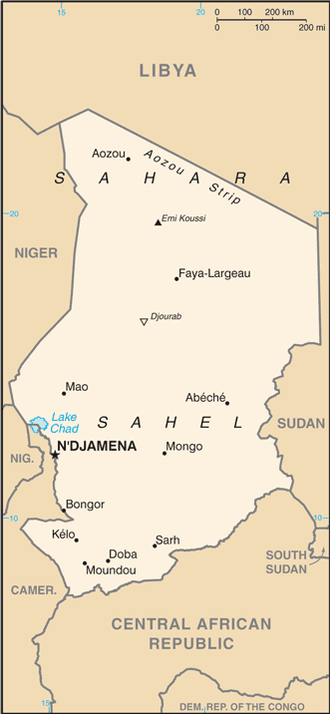
As of 2011, there are
in the country, 55 of which are endemic.[2] Precipitation varies widely from south to north of the country. The country is also subject to hot, dry, dusty conditions. Harmattan Winds are a feature in the northern part of the country. Droughts and locust plagues are also common. The vegetation in the country is broadly categorized under the three regions of the northern Sahara zone, the central Sahel zone, and the southern Sudan zone; all three zones are of equal proportion.[1]
The northern part of the country which has the Sahara desert and which borders Libya and the volcanic massif of Tibesti (3,415 metres (11,204 ft)) forms part of the northern zone. Vegetation is dominantly tropical in the tropical zone of the country with deserts having least vegetative growth. However, a large area of desert dunes lie between Lake Chad and the Ouaddai massif, where fringes of xerophytic scrubland is noted.[1]
The montane vegetation on the massif is rich, unlike the vegetation that is in the lowlands. Woody vegetation occurs in some deep gorges of the Ennedi massif, which rises to 1,450 metres (4,760 ft). A flat terrain supports Sahelian grasslands. The transition zone that lies between the southern Sahel and northern Sudan–Guinea is also a seasonal wetland.[1] The Sudan Savanna zone mostly consists of Sudanian woodland with intermittent vegetation of edaphic grassland and acacia.[1]
Lake Chad, lying on the country's western edge and extending across the border into Niger, Nigeria and Cameroon, is one of the richest areas of flora in the country, although it has rapidly reduced in size during the last century. The well-drained soils of the area once supported areas of dense woodlands with ebony and kapok trees, but this has declined due to soil erosion and degradation.[3] Vegetation found in the area includes acacias, baobab, desert date, palms, African myrrh, and Indian jujube. Found within the lake itself are aquatic plants such as reeds, Papyrus, ambatch, and water lilies.[3]
Fauna
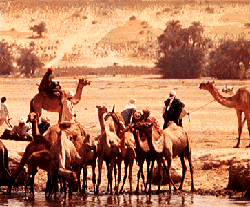
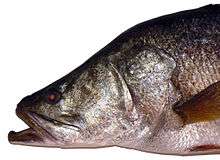
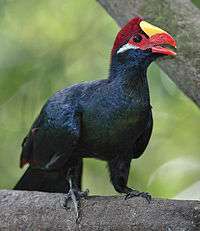
As of 2002, there were at least 134 species of mammals and 532 species of birds (354 species of residents and 155 migrants) in Chad.[1] Before the 20th century, Chad reportedly had a rich fauna of large carnivores in the Lake Chad region, but due to deforestation, hunting and competition from livestock most of the population of lions, leopards, rhinoceros, and hippopotamus have disappeared from the region.[3]
The Zakouma National Park is an important habitat with the highest number of large mammals.[4] Scimitar horned oryx are seen in the reserves of Chad in significant numbers, mostly in the Ouadi Rime Ouadi Achin Faunal Reserve. Also reported to survive in this reserve are the large population of addax (nasomaculatus) and dama gazelle Gazelle dama.[5]
Other species reported are; red-fronted gazelle, dorcas gazelle (Gazella rufifrons, Gazella dama, Gazella dorcas), patas monkey (Erythrocebus patas), striped hyena (Hyaena hyaena), Sudan cheetah (Acinonyx jubatus soemmeringii), caracal (Felis caracal), and Chadian wild dog (Lycaon pictus sharicus), African elephant (Loxodonta africana), otter (Lutra maculicollis), Aonyx capensis, sitatunga (Tragelaphus spekei) and kob (Kobus kob). Rodent species reported are Mastomys verheyeni and gerbil (Taterillus lacustris).[6] African rock pythons and spitting cobras are the reptile species also reported.[7]
Aquafauna
Lake Chad has 179 species of fish which feed on vegetation, phytoplankton and zooplankton. Some of the species reported are catfish (Clarias gariepensis), tilapia, cichlids, characin (Alestes baremoze) and Nile perch (Lates niloticus).[6] Lungfish and sailfin are the two other unique species in the lake.[7] Crocodile and hippopotamus also inhabit the lake as do birds, and it is an important destination for many migratory species of birds.[6]
Avifauna
While the Birdlife International Organization has reported 532 species of birds of which 354 residents and 155 are migrants, the Avibase - Bird Checklists of the World reports 587 species including 6 globally threatened species.[8] Of these the species under endangered, near-threatened, and vulnerable categories are:[8]
|
|
Musophaga violacea (violet turaco} is a species of least concern, which is found in large numbers in a range of less than 20,000 km2 (7,700 sq mi) covering many African countries including Chad[9]
Protection
| Wikimedia Commons has media related to Protected areas of Chad. |
The unprotected parks, reserves, protection forests, reforestation areas, and Ramsar drylands of International Importance in the country include the IUCN Level II categorized Aouk (7400 km2), Goz Beïda, Manda (1140 km2), and Zakouma (3000 km2) national parks. The country has a number of faunal reserves which are loosely protected including Abou Telfane (1100 km2), Bahr Salamat (20600 km2), Beinamar (763 km2), Binder-Léré (1350 km2), Fada Archei (2110 km2), Larmanaye (3040 km2), Mandelia (1380 km2), Ouadi Rimé-Ouadi Achim (80,000 km2), and Siniala-Minia (4260 km2) faunal reserves. Aside from the numerous protected forests, Tibesti Massif is also a protected area. The Wetlands of International Importance (Ramsar) are the Lac Fitri Ramsar Site (1950 km2), Réserve de faune de Binder-Léré Ramsar Site (1350 km2) and the Partie tchadienne du lac Tchad Ramsar Site (16481.68 km2).[10][11][12]
Apart from parks and reserves, eight Important Bird Areas have been identified and supported by Bird Life International covering an area of 146,500 square kilometres (56,600 sq mi) (11.2% of the area of the country) some of them overlapping with parks and reserves. Of these, the Ouadi Rimé–Ouadi Achim IBA is the largest covering an area of more than 6% of the area of the country.[1]
Conservation
Extensive deforestation has resulted in loss of trees such as acacias, baobab, dates and palm trees. This has also caused loss of natural habitat for wild animals; one of the main reasons for this is also hunting and livestock farming by increasing human settlements. Animals like lions, leopards and rhino have been almost decimated.[7]
Efforts have been made by the Food and Agriculture Organization to improve relations between farmers, agro-pastoralists and pastoralists in the Zakouma National Park (ZNP), Siniaka-Minia, and Aouk reserve in southeastern Chad to promote sustainable development.[13] As part of the national conservation effort, more than 1.2 million trees have been replanted to check the advancement of the desert, which incidentally also helps the local economy by way of financial return from acacia trees, which produce gum arabic, and also from fruit trees.[7]
Poaching
Poaching is a serious problem in the country, particularly of elephants for the profitable ivory industry and a threat to lives of rangers even in the national parks such as Zakouma. Elephants are often massacred in herds in and around the parks by organized poaching.[14] The problem is worsened by the fact that the parks are understaffed and that a number of wardens have been murdered by poachers.[15]
References
- "Important Bird Areas in Africa and associated islands – Chad" (PDF). Birdlife International Organization. Retrieved 16 October 2013.
- Brundu, Giuseppe; Camarda, Ignazio (2013). "The Flora of Chad: a checklist and brief analysis". PhytoKeys. 23 (23): 1–18. doi:10.3897/phytokeys.23.4752. PMC 3690977. PMID 23805051.
- "Plant and Animal Life". The Living Africa. Retrieved 17 October 2013.
- Brugière, David; Scholte, Paul (October 2013). "Biodiversity gap analysis of the protected area system in poorly-documented Chad". Journal for Nature Conservation. 21 (5): 286–293. doi:10.1016/j.jnc.2013.02.004.
- World Conservation Monitoring Centre 1991, p. 67.
- "Lake Chad flooded savanna". World Wildflife Organization. Retrieved 16 October 2013.
- "Our Africa". Our Africa organization. Retrieved 17 October 2013.
- "Avibase - Bird Checklists of the World Chad". Avi Base- The world data base organization. Retrieved 16 October 2013.
- "Musophaga violacea". IUCN Redlist Organization. Retrieved 17 October 2013.
- "Parks, Reserves, and Other Protected Areas in Chad". Parks.it. Retrieved 17 October 2013.
- "The National Parks and Nature Reserves of Chad". National Parks-Worldwide.info. Retrieved 17 October 2013.
- "Search for protected areas". Official Record. Protectedplanet.net. Retrieved 17 October 2013.
- "Livestock-wildlife-environment interactions in Chad". Food and Agriculture Organization. Retrieved 17 October 2013.
- "African Elephants Slaughtered in Herds Near Chad Wildlife Park". National Geographic. 30 August 2006. Retrieved 17 October 2013.
- Gettleman, Jeffrey (31 December 2012). "Rangers in Isolated Central Africa Uncover Grim Cost of Protecting Wildlife". The New York Times. Retrieved 17 October 2013.
- Bibliography
- World Conservation Monitoring Centre (1991). Protected Areas of the World: Afrotropical. IUCN. ISBN 978-2-8317-0092-2.CS1 maint: ref=harv (link)
External links
- USAID detailed study on "Considerations of Wildlife Resources and Land Use in Chad"
